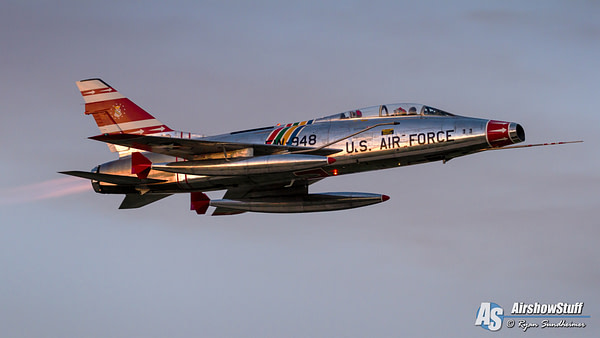North American Aviation F-100 Super Sabre
Check out this rare and awesome video of one of the only flying examples left of an F-100 Super Sabre! This video was taken at EAA AirVenture in Oshkosh back in 2015 and showcases the power and beauty of the F-100 with a stunning twilight backdrop. Be sure to pay particular attention to the afterburner as this powerful fighter-bomber of the 50’s and 60’s streaks by in pass after pass of polished metal glory. Pilot Dean “Cutter” Cutshall will put the F-100 through its paces, and you have a front-row seat to it all. And for a little bit of background on the F-100, read on about how this iconic aircraft cemented itself in aviation history.
History of the F-100 Super Sabre
In May of 1953, an unusual looking aircraft took to the skies for the first time. Sporting a gaping air intake where the nose would traditionally be located, along with a unique 45 degree swept-back wing design, the prototype F-100 Super Sabre took flight.
Building on the success of the F-86 Sabre jet, the North American Aviation F-100 Super Sabre was designed to be an air superiority fighter, and the first production fighter to be able to break the sound barrier while in level flight. The first of the so-called Century Series fighters, the Super Sabre carried four 20mm cannons on the bottom of the fuselage and a Pratt and Whitney J57 engine that propelled it to a maximum speed of about 850 mph. Later versions would receive an updated version of the J57 engine that would propel the “Hun”, as it was called, to a maximum speed of approximately 880 mph. With the exception of a handful of shows flown in the F-105 Thunderchief in 1964, the Super Sabre was the aircraft of choice for the USAF Thunderbirds from 1956 to 1969.
Though the Super Sabre was designed as an air superiority fighter, its ability as a tactical bomber became apparent, especially during the Vietnam war. Trading in the colorful and high-visibility silver lacquer paint schemes of the 1950’s, the Super Sabre began wearing the green and brown paint of the Southeast Asian conflict in its new role. The F-100D, the most produced variant of the Hun, became an adept ground attack aircraft platform and saved many friendly troops in direct action sorties by dropping a variety of ordnance from general purpose bombs, to rockets, to napalm. By the end of the Vietnam war, the F-100 had become the longest-serving fighter of any type, serving from 1961 to 1971. The Super Sabre was also the first aircraft to carry out the dangerous “Wild Weasel” surface-to-air missile suppression missions. Due to the heightened tensions of the Cold War, the F-100 could even pack a wallop with the capability of carrying five different types of tactical nuclear bombs.
With aircraft technology advancing rapidly in the 1950’s and 1960’s, the F-100 Super Sabres eventually became obsolete and were retired or transferred off to Air National Guard units. Some were even exported to other nations. The Hun was officially retired in 1979, but continued to serve proudly into the 1980’s as QF-100 drones. Despite being replaced by more technologically advanced aircraft in the 1970’s, you can see why the North American Aviation F-100 Super Sabre was one of the most powerful and capable fighter-bombers in history.
Once again, be sure to check out the video, turn up the volume, and enjoy the sights and sounds of the F-100 Super Sabre. You won’t be disappointed!
– Justin Miner





Leave a Reply